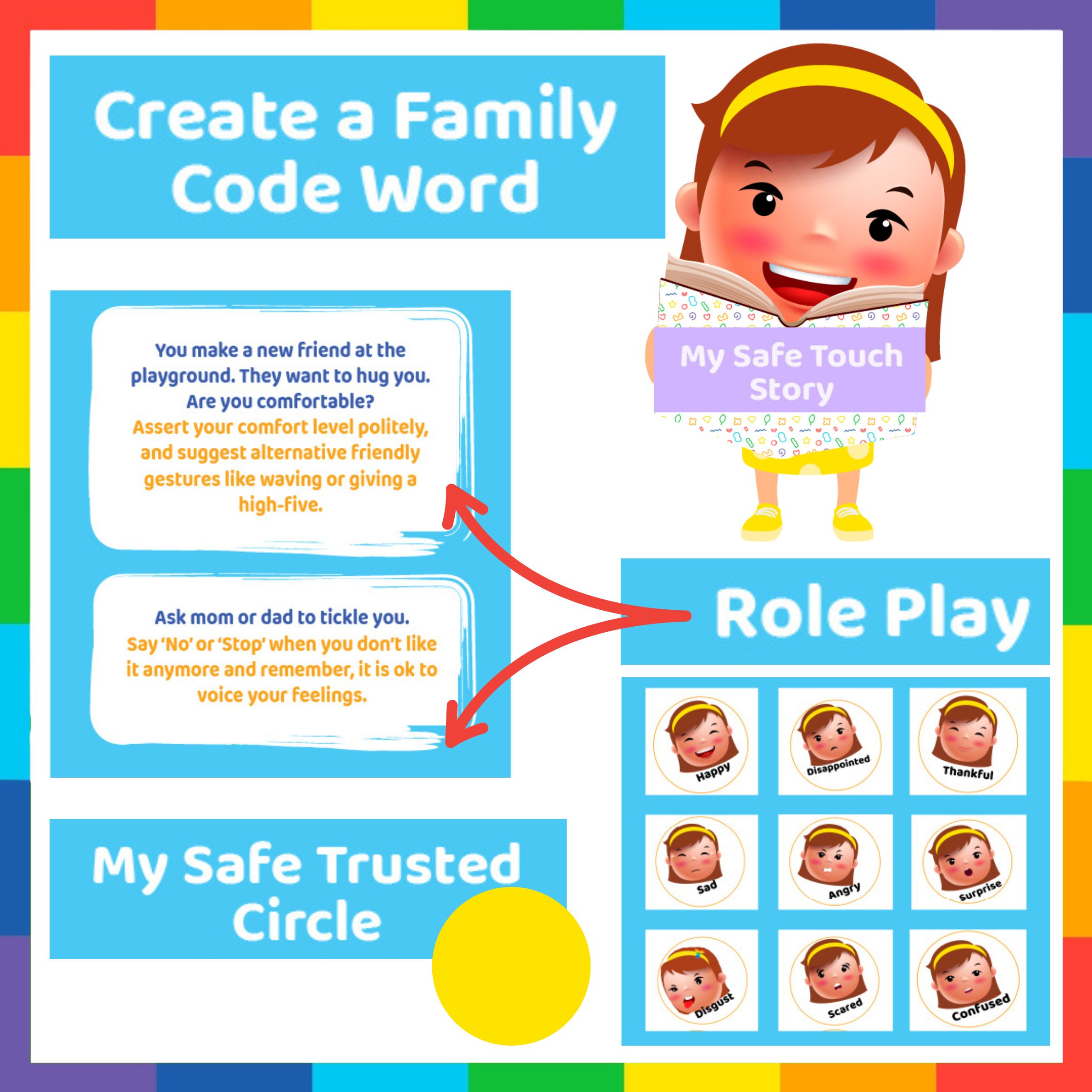
Quick Bites
Debunk Common Myths About Safe Touch: Know the Truth
February 23, 2025
Related
Topics

Hey
-

Resilience-Building – Easy Checklist for Kids of All Ages
August 13, 2025
-

-

How to Ensure Body Safety of Your Kids? – Summary
February 27, 2025
-

Debunk Common Myths About Safe Touch: Know the Truth
February 23, 2025
-

How to Reinforce Body Safety and Consent?
February 16, 2025
Ready for more?
Hey
Sign up for Rainbow Kiddies newsletters for more stories and updates
Safe touch education is one of the most important lessons we can teach our children. It empowers them to protect their boundaries and builds the foundation for healthy relationships. However, misconceptions about safe touch often prevent parents and caregivers from addressing this crucial topic effectively. In this blog, we’ll explore some of the most common myths about safe touch and provide practical insights to help you navigate these conversations with confidence.
Myths about Safe Touch 1: “My child is too young to understand safe touch.”
Reality: It’s never too early to start teaching your child about their body and boundaries. Even toddlers can begin to understand basic concepts of personal space and privacy. Use simple language, such as “Your body belongs to you,” and teach them the names of their body parts, including private parts, using correct anatomical terms. Early education lays the groundwork for understanding consent and recognizing inappropriate behavior as they grow.
Tip: Incorporate books like “My Safe Body Bubble“ into story time to introduce these ideas in an age-appropriate way.
Myth 2: “We don’t need to talk about this; we’re always around to protect them.”
Reality: While being a present and vigilant caregiver is essential, it’s impossible to supervise your child 24/7. Children encounter various situations at school, during extracurricular activities, or even within extended family settings. Educating them about safe touch ensures that they can identify inappropriate behavior and seek help, even in your absence.
Tip: Create a “circle of trust” by helping your child identify adults they can approach if they feel uncomfortable, such as teachers, relatives, or school counselors.
Myths about Safe Touch 3: “Strangers are the only danger.”
Reality: While “stranger danger” is a concern, statistics show that most cases of abuse are perpetrated by someone the child knows and trusts. It’s crucial to teach children that inappropriate behavior can come from anyone—a family member, friend, or even another child.
Tip: Avoid framing the conversation around “bad people.” Instead, focus on behaviors: “If anyone—even someone you know—touches you in a way that makes you feel uncomfortable, you should tell me. I got your back.”
Myth 4: “Talking about private parts will make my child curious about sex.”
Reality: Using correct anatomical terms for private parts does not lead to premature curiosity about sex. Instead, it normalizes discussions about the body and helps children communicate clearly if they need to report inappropriate behavior. When private parts are treated as taboo, children may feel shame or hesitation in discussing their experiences.
Tip: Use everyday opportunities, such as bath time or dressing, to talk about private parts in a matter-of-fact way. Reinforce that private parts are special (‘my body belongs to me’) and deserve to be protected.
Myth 5: “It’s rude to refuse hugs or kisses from family members.”
Reality: Forcing a child to hug or kiss someone—even a relative—sends the message that their boundaries are less important than someone else’s feelings. This can make it harder for them to assert themselves in uncomfortable situations later on.
Tip: Encourage your child to express affection in ways that feel comfortable for them, such as a wave, a high-five, or a verbal greeting. Respect their choice if they decline physical contact. Watch this video with them to help them understand this better.
Myths about Safe Touch 6: “They’ll always tell me if something is wrong.”
Reality: Children often hesitate to share experiences of inappropriate touch due to fear, confusion, or guilt. They may worry about not being believed, upsetting their parents, or getting someone they care about in trouble.
Tip: Foster an environment of open communication by reminding your child regularly: “You can tell me anything, and I’ll always believe you.” Avoid reacting with anger or disbelief if they disclose something; instead, thank them for trusting you and take appropriate action.
Myth 7: “Boys don’t need to learn about safe touch as much as girls do.”
Reality: Safe touch education is equally important for boys and girls. Boys can also experience inappropriate touch, and they may feel additional societal pressure to stay silent due to harmful gender stereotypes about masculinity.
Tip: Teach boys and girls alike about their right to set boundaries, respect others’ boundaries, and seek help if needed. This will also help boys respect girls as they grow up. The day every gender understands boundaries and consent equally well, we will finally have a world which sees no sexual crimes against any gender.
Myths about Safe Touch 8: “One conversation is enough.”
Reality: Safe touch education is not a one-time talk. As children grow, their understanding of boundaries and consent evolves. Regular, age-appropriate conversations help reinforce these lessons and provide opportunities to address new questions or concerns.
Tip: Use everyday situations, such as playing with friends or visiting the doctor, to revisit and reinforce concepts of safe and unsafe touch.
How to Get Started
If you’re unsure how to begin these conversations, here are a few simple steps:
- Normalize the Topic: Use everyday moments like bath time or dressing to introduce body safety in a casual, non-intimidating way.
- Use Clear Language: Teach your child correct anatomical terms and phrases like, “Your body belongs to you.”
- Practice Scenarios: Role-play situations where they might need to say “no” or report something to an adult.
- Be Open and Approachable: Remind your child regularly that they can talk to you about anything without fear of punishment or judgment.
Conclusion
Breaking down myths about safe touch is essential for creating a culture of safety, respect, and empowerment for our children. As caregivers, it’s our responsibility to equip them with the knowledge and confidence to protect their boundaries and seek help when needed. By addressing these misconceptions and fostering open communication, we can ensure our children grow up informed, confident, and safe.
Remember, safe touch education is a journey, not a destination. Start small, stay consistent, and always listen. Your efforts today will make a world of difference for your child tomorrow.
Sign Up for your Free Parenting Guide: “10 Everyday Ways to Raise an Emotionally Strong Child”

